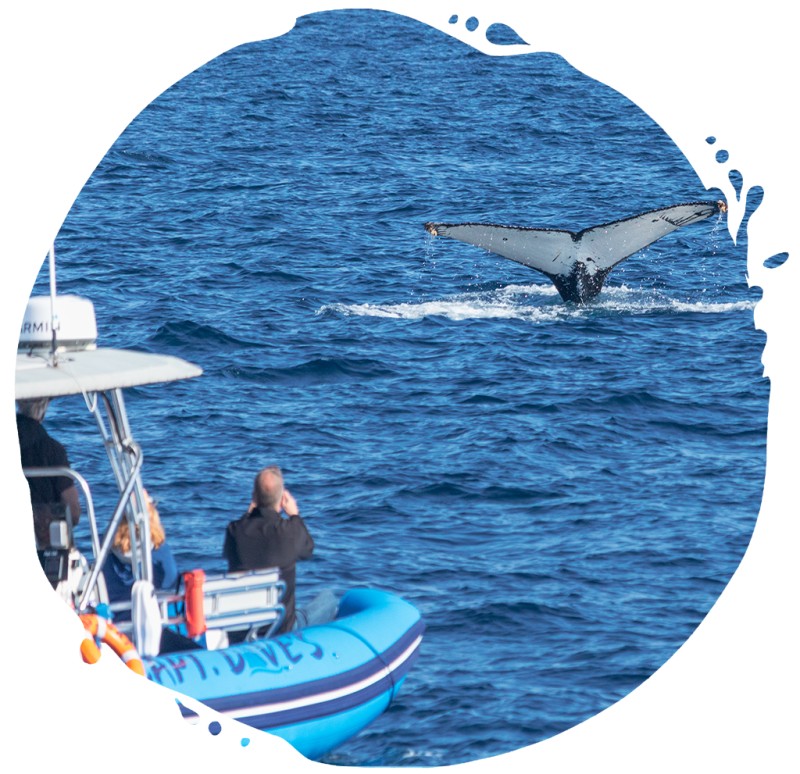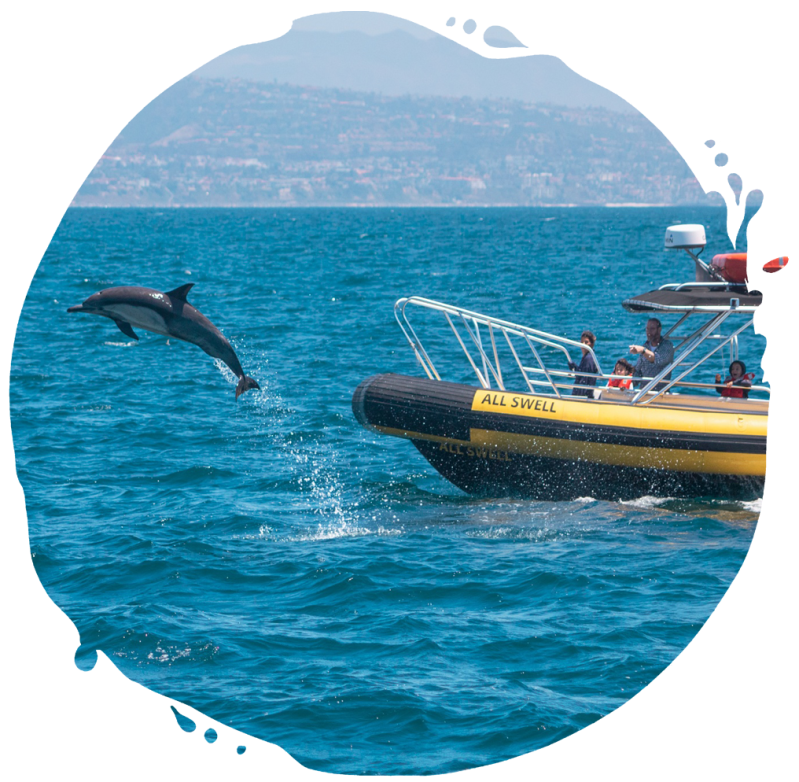EMBARK ON A FAST & FUN ZODIAC WHALE WATCHING ADVENTURE IN DANA POINT!
WHAT SETS CAPTAIN DAVE’S WHALE WATCHING DANA POINT SAFARIS APART FROM THE REST?

TOP-RATED TOURS
Our dolphin and whale watching tours in Dana Point are among the highest rated on Tripadvisor, Yelp, Facebook, and Google!
We’ve been dubbed the “Best Whale Watching in the World” by CBS Los Angeles. We’ve also received Tripadvisor’s Traveler’s Choice award every year since its inception, proving our dedication to providing consistent top-notch customer service!

ECO-FRIENDLY
We’re dedicated to being good stewards of the ocean! As an eco-friendly tour operator, we’re committed to providing sustainable whale watching Dana Point boat tours.
We use the best sustainable technology available and never run tours from fishing boats. We also host beach clean-up events and conduct marine conservation efforts like whale disentanglement and rescue.

NEVER CROWDED
Avoid the crowds on those larger, stuffy tour boats! With a maximum capacity of about 20 passengers, you won’t feel like just another number on a packed whale watching Dana Point wildlife viewing tour.
Our small group experiences on our zodiac-style vessels offer a more intimate whale watching Dana Point experience. And with faster speeds, you’ll spend less time looking for animals and more time enjoying them!
EXPERIENCE YOUR OWN UP CLOSE ADVENTURE ABOARD THE TOP-RATED WHALE WATCHING DANA POINT TOUR IN SOUTHERN CALIFORNIA!
Whale Watching in Dana Point is undoubtedly thrilling, and high-speed zodiac whale watching tours are hands down the most exhilarating and adventurous way to experience the pristine clear blue oceans of Dana Point, California, the Whale Watching Capital of the World®. Nowhere else in the world has such a vast variety of cetaceans and marine life in one place. Now that’s something we are flipping flukes over! Our super safe, never overcrowded, fun for the whole family to enjoy eco-tours are an open sea adventure waiting for you and your guests. Book a trip today for your family, friends, or both and come and enjoy whale watching Dana Point excursions throughout each season, all year round!
No matter what time of year you decide to join us, if you are looking for a high-speed, thrill-seeking zodiac whale watching tour adventure that will get your heart racing, Captain Dave’s Zodiac Whale Watching in Dana Point is the #1 choice! We bring you up close and personal with dolphins, whales, and local marine wildlife making this trip sure to leave a lasting impression on your heart, your memory, and your soul!
To make things even better about this area, whale watching Dana Point season isn’t seasonal. This year-round activity means you can enjoy whale watching the whole year through. Home to an assortment of sea life like enormous and magnificent blue whales and finback whales – two of the largest mammals to ever live on planet earth, plus more whales and a variety of different species of dolphins, seals, California sea lions, molas, turtles, sharks, and more!
Whether it’s catching a glimpse of a breathtaking baleen whale or getting to witness hundreds of dolphins stampeding in pods or mega herds into the thousands, every day of each season provides you with the chance to experience the incredible wildlife this region has to offer. Plus, whale watching Dana Point adventures are located in the heart of the very first Whale Heritage Site in the Americas, making our intimate boating tours an experience you will never forget. Regardless if it’s your first trip with us or your 101st time out with Capt. Dave’s Zodiac Whale Watching, your whale watching Dana Point adventure is waiting for you to come aboard.
Don’t delay. Book your zodiac whale watching tour today!
WHAT TYPES OF WHALES DO WE SEE AND WHEN DO WE SEE THEM?
All dolphins are whales, but not all whales are dolphins! Does that statement smell a little fishy to you? Well, believe it or not, it’s o-fishally true! The dolphins we see belong to a family of whales called Odontecetes, or toothed whales. Plentiful in both deep and coastal waters, dolphins in Dana Point are lively, social and in some species can be sighted in groups of hundreds to thousands! These spritely creatures commonly grace our water in search of much of the same food as California sea lions and sunfish are in search of, and our nutrient dense water makes for the most thrilling whale watching Dana Point adventure.
While a toothed whale’s teeth masticate food, larger rorqual whales we see have the presence of baleen instead of teeth. The baleen acts more like a sieve, allowing water to expel through the baleen plates, trapping massive amounts of food inside. Can you believe that blue whales open their mouths up to 10 feet wide when feeding on nearly 16 tons of krill a day! These astounding beauties can hold enough water in their mouth to fill an average-sized swimming pool before expelling it through their two blowholes. Seeing this spectacular sight while zodiac whale watching is sure to make you and all your friends feel amazing!
Whale watching in Dana Point gives you the opportunity to join the one percent of people who have seen these incredible animals perform natural behaviors in the wild. Now that is whaley cool if you ask us! If you think seeing 3-ton animals thrust themselves gracefully out of the water then you are breaching to the choir! Bringing you to the water’s edge, almost close enough to touch the sea, and will take your breath away when magnificent giants of the sea swim nearby. It is truly a magical sight to see. But don’t just take our word for it! Check out our five-star reviews on Google, Trip Advisor, Yelp, and more and reserve your seat aboard Capt. Dave’s zodiac tours and join a whale watching Dana Point experience today!
Baleen whales like blue whales, gray whales, and humpbacks all provide an extraordinary example of whale species traveling further in their migration patterns than most other types of whale species. We are thrilled to be able to share these animals with our passengers throughout the year depending on the species. Traveling together means becoming one of the masses when you are seeing dolphins on your whale watching Dana Point tour. Whether it is a solitary or small pod of large whales or more dolphins than you can count, we promise that you will have the very best seat in the house zodiac whale watching with us!
-
Did you know that blue whales are not blue? Blue whales gain their colorful names from the beautiful blue hue of the water created by tiny diatoms on their skin. Late spring and summer, whale watching Dana Point brings about the presence of magnificent and giant blue whales. Weighing over 150 tons and extending to lengths over 100 feet in some parts of the world, blue whales are the titleholders of the largest mammal on earth. Just outside of our very own Dana Point Harbor, off the sunny and extensive food source of the Dana Point coastal area, is the best place to see whales! Exhaling their impressive 100 foot long bodies (dwarfing all of our zodiac whale watching vessels), reminding all of us of the impactful meaning these animals can have on our lives, is a sight to see.
Capturing a glimpse of a blue whale when whale watching in Dana Point is one of the rarest sights to see in the world. In fact, only 1% of all people on Earth will ever see a blue whale. Baby blue whales are even more amazing to see as they capture our hearts as newborns at their astonishing 23 feet in length. That is about the same size as a full-grown African elephant! Times that number by 30 and you have an adult blue whale that is the same weight as about 30 elephants or roughly 2,500 people. Now that is really BIG!
Nothing about the blue whale is small. Their hearts are the size of a Volkswagen Beetle car, their arteries the size of a 9-inch dinner plate, and their massive tongue weighs as much as a single elephant. The great blue whale is more than just a miraculous sight to see. Having the reputation of being the largest whale is one thing but touting the accolades of being the largest animal to have EVER roamed planet earth is certainly worth showing off!
When zodiac whale-watching, each and every year Dana Point whale watching evolves. We are thrilled to see the consistent reappearance of these amazing animals and share our knowledge and love of these precious creatures with passengers and repeat passengers alike on our thrilling zodiac adventure tours.
-
The second-largest living animal on earth holds several other accolades making them a cherished site to see. Just short of the length of a blue whale, fin whales (also known as finback whales) are approximately 85 feet in length and tip the sea scales between 75 – 90 tons! Found in every ocean everywhere in the world except arctic waters, where the water is covered in ice most of the year.
Being the second-largest animal on earth makes their blows hard to miss when whale watching off Dana Point. Reaching 18-20 feet up in the air, it is as recognizable as their dark falcate or curved dorsal fins. Unlike all other baleen whales, fin whales have a unique asymmetric coloring, making them easier to spot on the water. The right lower jaw is always primarily white, and the left lower jaw is dark or black. This unusual balance of color also continues inside their mouths. Inside, their baleen is a creamy white on the right side, whereas on the left, it is a blackish grey. On the endangered species list with only 100,000 fin whales left on earth, taking a whale watching Dana Point trip out at sea could secure you a first-row seat to seeing these majestic beauties in the wild aboard one of our zodiac adventure voyages.
-
Swiftly swimming into first place and voted the best acrobats of the sea are the iconic humpback whales. These sing-song beauties communicate with longer melodic choruses sometimes lasting twenty minutes in length. They are also large and in charge, weighing about one ton at birth and reaching larger lengths of about 10 feet on the day of their birth.
Whale watching Dana Point gives passengers an up-close view of these mighty whales who are best known for males singing their songs sounding more like moans, cries, and howls. Both females and males will lobtail, spy hop, breach and their extra-long pectoral fins measuring over a ¼ of their body size and an average over 16 feet long make a when they slap the surface of the water. These massive pectoral fins are what allow them to propel themselves through the water fast enough to fully extend out of the water.
Whale watching Dana Point sea-goers have the chance to see these playful and precious cetaceans who often travel in groups sizes ranging from 2 to 12 animals at a time. Passengers who go zodiac whale watching also get a picturesque view of their amazing tails or flukes which are like fingerprints to this specific species. Their individual markings allows us to see who is a return visitor and who is new to the pod.
Thirsty for more whale knowledge? Humpback whales can take a deep dive for nearly 20 minutes so they possess lots of earwax! A column of earwax over a foot long prevents water from entering the whale’s ear canal during dives. Visitors who go whale watching in Dana Point will learn more crazy, interesting and incredible facts like this from our highly experienced captains and crews including the defining characteristics of celebrity whales we can identify and who is or has been seen recently in the area.
-
While it may be hard to say, Eschrichtius robustus of the family Eschrichtiidae is the scientific name for one of our most beloved whales who make an appearance each and every autumn, winter and spring as they make their way south down the Pacific Coast each year.
More commonly known as gray whales, these barnacle-covered brown beauties will often hug our Southern California coastline as they head down to the lagoons of Mexico where they will have their young.
Whale watching Dana Point means having the chance to connect with these animals on our adventurous zodiac whale watching tours.
Gray whales are the title holders for having one of the longest migrations of the entire baleen whale species. Traveling over 5,000 miles in each direction, sometimes migrating over 12 thousand miles roundtrip, these robust charmers usually do not eat along the route – pregnant mamas included. Now that is one heck of an arduous seaworthy adventure if you ask us! Not many other species in the world can hold a title like that!
Whale watching Dana Point tours will often receive an up-close look at these gentle bottom feeders who use their coarse baleen as a sieve, sucking out small invertebrates like amphipods, ghost shrimp, crab larvae from the cold arctic ocean seafloor.
Gray whales lack dorsal fins and instead have a small hump followed by a series of ‘knuckles’ two-thirds of the way back from the head with bodies that are mottled grey in color making them unique to other baleen whales. Known for being covered in heavy infestations of barnacles and sea lice, gray whales have more hitchhikers than any other cetacean! Whale watching Dana Point tours are thrilling when we see their 9 to 12 foot bushy, heart-shaped blow spouts, and they take the top spot for being Valentine’s Day’s favorite whale on our zodiac whale watching trips.
-
Pronounced “broo-duhs” and named after Johan Bryde, a Norwegian who built the first whaling stations in South Africa in the early 20th century, these pelagic baleen whales are unique for more than just their pronunciation of their name.
Bryde’s whales have three prominent ridges in front of their blowhole are their defining characteristic along with their dark gray with a white light pink belly. Passengers aboard whale watching Dana Point tours with Capt. Dave’s Dolphin and Whale Watching will see their falcate dorsal fin (much like that of the fin whale) located at the back one-third of their body.
Bryde’s whales also have the uncanny ability to change directions unexpectedly when swimming which makes it fun to sight them in the wild as they can take a breath and pop up anywhere. While they sometimes will exhale under the water, when they blow at the surface their blow reaches about 10 feet in the air.
They can be curious creatures and will often approach boats giving Dana Point whale watching trips an awesome sighting of these striking animals. When at the surface, they often show much of their head then roll sharply and arch back, heading back down below the surface giving zodiac whale watching passengers an unforgettable sight.
Although they rarely show their flukes when diving, Bryde’s whales spend most of the day within 50 feet of the water’s surface because they use different methods to feed in the water column, including skimming the surface, lunging, and creating bubble nets. While some populations make short migratory movements as the season’s turn, whale watching Dana Point trips have the chance to see these amazing animals all year long making them even more unique among other migrating baleen whales.

-
The second smallest baleen whales (to the Pygmy Right whale) are the minke whales scientifically known as Balaenoptera acutorostrata. More commonly called stinky minke’s,” a name dubbed due to their diet of foul-smelling anchovies, are not so little. These elusive and sometimes shy whales are the lightest and the shortest of the rorquals weighing a mere 700 – 1,000 pounds at birth and are about 8-11.5 feet in length until they reach full size at nearly 30 feet at adulthood, measuring longer than both our inflatable boats offered on our Dana Point whale watching trips. Found worldwide, these fast swimming, delightful, yet stinky minke whales are sighted year-round in Dana Point, California giving passengers on our zodiac whale watching tours the chance to see and smell them every single day of the year. Like humpback whales, minke’s are easily identifiable for their gray stripe or ‘chevron’ on the side by their flippers and their very distinctive bright white ‘bands’ on the pectoral fins, minke whales area also individually identifiable by their coloring and scarring on their dorsal surfaces and flanks.
THE TOOTHED WHALES (A.K.A., DOLPHINS)
Dana Point, the Dolphin and Whale Watching Capital of the World®, is a spectacular place to see several different types of dolphins in their own free and natural habitat. Whale watching Dana Point excursions are more like a marine playground for dolphins and are one of the best ways to enjoy a vast variety of marine life too. Named as the first-ever Whale Heritage Site in the Americas, the plethora of marine life in this area is one of the pivotal reasons this stretch of ocean is a much-desired vacation destination location and a perfect spot to book a trip out at sea. Our zodiac whale watching tours give you and your guests the chance to see family groups of these spectacular species and provide the opportunity for a whale watching Dana Point dolphin dream to become a reality.
Imagine swiftly zooming over the water at top speed while keeping pace with a pod of dolphins in the free and wild ocean. Dolphins are built for speed! This extraordinary group of toothed whales called Odontocetes have characteristics making them unique to other whales like larger rorquals in that they have teeth, and are all about their family. Dolphins swim together, hunt together, play together, and often stay together within their family pods for a large portion of their life, if not their entire lives. Read on below to learn about the dolphins we see on our trips!
-
Delphinus delphis from the family Delphinidae are our whale watching Dana Point heroes of the sea. So many people come for the whales, but they stay for the dolphins. We have more dolphins per square mile than anywhere else on the planet!
While there is nothing common about these lively little ones other than the fact that they can be found in every ocean everywhere in the world, common dolphins are the most abundant of all of the dolphin species in our water in Dana Point, California. Over 450,000 common dolphins between two species call this beautiful place their home on earth and passengers on our zodiac whale watching tours have the best seat on the water to see them.
Gregarious, social, and always gorgeously dressed in their characteristic hourglass two-tone coloring, both of these species will travel in large family groups called pods. When multiple family groups combine we call these groups herds and these herds can be spotted in hundreds, thousands and have been recorded up to ten thousand too!
Whale watching Dana Point tours give the chance to see both short-beaked and long-beaked common dolphins right next to the boat. While their names may sound similar, zodiac whale watching with Capt. Dave’s Dolphin and Whale Watching Safari’s get you close enough to almost touch them!
From the boat, we look for lots of splashing in the water and a glimpse of their tall, triangular dorsal fin set in the middle of their sleek dark back. When we see these incredibly active mammals during a whale watching Dana Point cruise there is not a bad seat in the house.
They frequently swim up to check us out and will often decide to stay and have some fun of their own using the pressure of the waves, they love bow riding and can be seen enjoying the propulsion of the wake of our stern.
Soaring to new heights with jaw-dropping high flying acrobatic leaps out of the water they show off their beautiful almond shape hourglass color patterns to our passengers smiling down at them from aboard our zodiac whale watching outings. When they breach or stampede out of the water it’s the perfect opportunity to catch a glimpse of those beautiful yellow undertones on both the right and left sides. Dana Point made famous the dolphin stampede!
When whale watching in Dana Point, short-beaked common dolphin and long-beaked common dolphin may be different types of dolphins, they also have many similarities too. Both species are as friendly as they come, weigh between 180 to 500 pounds, and have teeth! Short-beaked common dolphins are more robust and also slightly smaller than their long-beaked relatives, measuring in at six feet long which is relatively small when compared to the long-beaked common dolphin who reach lengths of 6 to 8.5 feet long.
With age comes beauty. Mature adults will have more prominent coloring whereas the youngsters are often much lighter in color. Whale watching in Dana Point also allows us to see one additional marking difference between these different types of dolphin species. The dark-colored cape covers the eye area of the long-beaked species, whereas it does not cover the eye area of the short-beaked common dolphin.
-
Originally made famous by the TV show “Flipper”, bottlenose dolphins always bring contagious dolphin smiles with them everywhere they go. Zodiac whale watching is extra fun when sighting bottlenose dolphin families which can be seen on any given day right here in Dana Point, California. These highly intelligent and social ocean cetaceans are an absolute favorite sighting amongst passengers when whale watching in Dana Point.
Like all Odontecetes, toothed whales are all about family, and bottlenose dolphins are no exception. Interacting with one another as a form of play, they love, fight (and “makeup”) and will also mourn the death of their loved ones much as we do in times of loss. Working together as one unit forming elaborate strategies to corral fish into tight bait balls they always make sure everyone on the pod has an equal and fair share of the food.
Their slick, rubbery skin keeps their bodies sleek and free to reach high speeds under the water making Dana Point whale watching so much fun! Seeing babies are extra special before these beauties reach adult lengths of eight to twelve feet and can weigh upwards of 1,000 lbs. In the wild, these gorgeous, gregarious, and friendly creatures can live up to 40 years out at sea. Some females outlive males and reach well into their 60’s!
We love to see the ocean thriving with these animals while travelling the open ocean and zodiac whale watching. Sadly, this species is also amongst the most common captive species found in hotel tanks, amusement parks, and oceanariums throughout many countries and are sought after for their ability to be trained to do high flying tricks that show off their amazing acrobatic skills.
-
Risso’s dolphins are probably the most unique species of dolphin we see during whale watching Dana Point cruises due to their discolored markings. Born dark gray, black, and even brown, their color will change over time into a pale gray and almost white tone as they age, much like us!
The first question that quickly comes to mind is, “Why do Risso’s dolphins have unusual white markings?” The answer is an easy one for this chaotically colored mammal. Scarring from daily social interactions with dolphins within their own pods, as well as tattoo-like scarring leftover from eating their favorite items on the menu, squid and cookie-cutter sharks, give Risso’s their unique markings. While whale watching in Dana Point we can see their circular white scarring patterns on their skin.
Adventuring through the water on zodiac whale watching trips shows passengers the telltale signs of Risso’s encounters with squid, another Risso’s dolphin “favorite” when ordering off the oceans à la carte menu.
Risso’s dolphins have more of a rounded square-shaped bulbous head, much like that of a pilot whale, with no distinguishable beak, and are much larger than the common dolphins. This makes them very recognizable when whale watching off Dana Point coastline.
Not a small dolphin, they are roughly anywhere from 660 to 1,110 pounds. Typically, Risso’s dolphins will reach lengths of up to 13 feet and because Risso’s dolphins can hold their breath for up to 30 minutes while diving to depths of up to 1,000 feet below the surface, we typically find these animals a few miles off the shore during whale watching Dana Point tours.
-
Thanks to their mouthful of a scientific name, these dolphin are often called “lags”. They make their way into our waters during the autumn and winter months. Named for their elegant white contouring along their sides underbelly and dorsal fin with white stripes that extend from above the eye along the sides, these stunning ocean dwellers have a tall and sharply hooked dorsal fin making them a unique sighting when zodiac whale watching in Dana Point.
Much like the bottlenose, these dolphins are very fast. Energetically swimming and riding the pressure of the waves of the bow for extended periods of time is one of their favorite play activities. Whale watching Dana Point cruises get a chance to see these very social and active animals. They are commonly seen breaching and showing off their high-flying acrobatics and aerial somersaulting skills.
Like offshore bottlenose and Risso’s, Pacific white-sided dolphins also eat squid and small schooling fish such as anchovies, herring, sardines and will travel in large herds of up to 100 in search of prey. This species intermingles with larger rorquals in the area such as fin whales and humpbacks.
These stunning wild dolphins live into their 40’s and whale watching Dana Point adventures reminds us just how incredible they truly are. However, like all dolphins, their lifespan is cut short due to environmental hazards like ocean noise, and while they no longer fished for their meat, they can become entangled in commercial fishing nets. Other than humans, their main predator is the killer whale.
-
The unprecedented black and white camouflage coloring of orcas, or more commonly referred to as killer whales, is what sets these animals apart from all other whales in the sea. No other animal on earth hunts orcas. Humans stealing young orca for an aquarium are this animal’s biggest threat.
In Dana Point, whale watching doesn’t often encounter these animals, but they do surprise us with a visit on our zodiac whale watching trips from time to time. These apex predators of the sea win the gold medal for being atop the ocean food chain. Surpassing all others with their supreme intelligence with the largest brain on earth, surpassing even that of the sperm whale, these supreme beings communicate using their own dialects and have passed down behaviors using their own family languages. Sighting this top predator of many of the whales and dolphins we see out here during whale watching Dana Point boat tours is a sight to see.
Killer whales belong to a very important category of toothed whales called Blackfish, which also includes both pilot whales and false killer whales. While pilot whales have been spotted in Dana Point, California, their visits remain few and farther between and are some of the most special. False killer whales tend to love Mexican waters to our south, but over the years have also paid us a visit during several of our zodiac whale watching tours.

